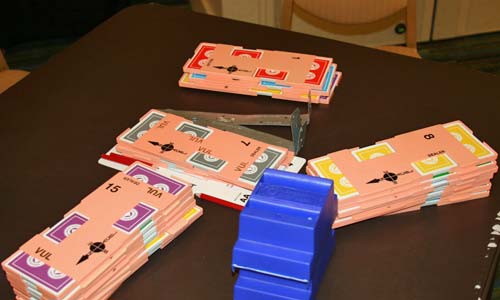Knowing the mathematical odds for playing bridge hands will give a player an edge when competing in tournament bridge. When you compare yourself as a bridge player to other players, often the person who has a better understanding of the bridge hand odds will make better decisions during the play of the hand. For instance, knowing statistics on the probabilities of hand distribution and high card points can help you make better choices as to the right course of action during the hand.

How about the likelihood of either of the two partnerships having enough to bid game holding a collective 26 or more points, well the probability is 25.3 percent which is about 1 in every 4 deals. Compare that to the percentage chance that either of the two partnerships will have 33 or more points and be in a position to bid slam, a measly .7 percent, which is 1 out of every 143 hands dealt. For either partnership to have a grand slam hand with 37 plus high card points the odds are .02 percent, a situation that occurs only one time every 5,848 deals.
How often do you think you will be dealt a hand with 37 high card points, essentially all four aces, four kings, four queens and one jack? Well it certainly does not happen very often with the official number being once out of every 158,753,389,899 deals.
You are dealt a hand with no aces 2:1
You will have at least one singleton 2:1
Odds of having at least one void 19:1
Chances of nobody at the table will be dealt a singleton or a void 4:1
Five honors in a suit 500:1, Four honors in a suit 22:1
How about the odds of being dealt a really weak hand, for instance a hand with no card higher than a queen 11:1
The probability of receiving a certain number of high card points during the deal is something that can help you understand hand strength which will improve your bidding and play.
| 27-37 high card points | 0% |
| 26 | .01% |
| 25 | .03% |
| 24 | .06% |
| 23 | .11% |
| 22 | .21% |
| 21 | .38% |
| 20 | .64% |
| 19 | 1% |
| 18 | 1.6% |
| 17 | 2.4% |
| 16 | 3.3% |
| 15 | 4.4% |
| 14 | 5.7% |
| 13 | 6.9% |
| 12 | 8% |
| 11 | 8.9% |
| 10 | 9.4% |
| 9 | 9.36% |
| 8 | 8.9% |
| 7 | 8% |
| 6 | 6.6% |
| 5 | 5.2% |
| 4 | 3.9% |
| 3 | 2.5% |
| 2 | 1.36% |
| 1 | .79% |
| 0 | .36% |
One of the odds that you should be aware of when playing bridge is the probability of hand distributions. Knowing the likelihood of getting certain combinations of cards can help you make better decisions as to the chance of the hand distributions your opponents and your partner are holding.
The most common hand distribution is one in which you have 5 cards of the same suit as your longest suit. You will be dealt a 5 card suit 44.34 percent of the time. The 5-3-3-2 hand distribution occurs 15.5%, 5-4-3-1 occurs 12.9%, 5-4-2-2 occurs 10.6%, 5-5-2-1 occurs 3.2%, 5-4-4-0 occurs 1.2%, and 5-5-3-0 occurs .90% of the time.
The second most common hand distribution is the 4 card suit as the longest suit in your hand. You will be dealt a 4 card suit as the longest suit 35.1 percent of the time. The 4-4-3-2 hand distribution occurs 21.6%, 4-3-3-3 occurs 10.5%, and the 4-4-4-1 occurs 3.0% of the time. Note, the 4-4-3-2 is the overall most common way a hand in bridge is distributed.
Getting dealt 6 cards of the same suit as your longest suit occurs 16.55 percent of the time. Having a long suit can have some advantages and disadvantages and is a situation you will face about once every 6 or 7 deals. The 6-3-2-2 hand distribution occurs 5.6%, 6-4-2-1 occurs 4.7%, 6-3-3-1 occurs 3.5%, 6-4-3-0 occurs 1.3%, 6-5-1-1 occurs.71%, 6-5-2-0 occurs .65% of the time.
Having 7 cards of the same suit is a situation that only occurs 3.9 percent of the time, or about once in every 25-26 deals. The 7-3-2-1 hand distribution occurs 1.9%, 7-2-2-2 occurs .51%, 7-4-1-1 occurs .39%, 7-4-2-0 occurs .36%, 7-3-3-0 occurs .27%, and the 7-5-1-0 occurs .1% of the time.
Other hand distributions with 8, 9, 10, 11, 12 or 13 cards of the same suit are extremely rare. Together the percentage chance of having one of these type hands is only .5% combined. This means that 1 out of 200 hands that you are dealt will have 8 or more cards of the same suit in it.
One thing to realize is that there are 39 different hand distribution patterns. The top 5 most common hand distributions are 4-4-3-2, 5-3-3-2, 5-4-3-1, 5-4-2-2 and 4-3-3-3. These five hand distribution patterns account for 70 percent of all hands dealt.
